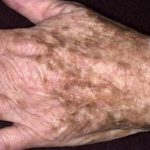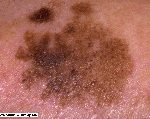October 5, 2017 | Stephen Fine, Founder and President
Age Spots and Melanoma
If you’re a nonmedical layperson, you know them as age spots, sun spots or liver spots. If you’re a doctor, they’re solar lentigines or actinic lentigines. Whatever you call them though, while visually unappealing most age spots are benign (safe/noncancerous). They can start to appear as early as a person’s 40’s, usually on the face, neck and backs of hands.
However, some develop into a form of in situ (in place) melanoma called lentigo maligna. From there between 5 to 20% of lentigo malignas can further develop into the invasive lentigo maligna melanoma, over the course of a 5 to 20-year span. On its own, lentigo maligna doesn’t pose much risk. But it becomes far more hazardous if a melanoma forms inside of it.
Most age spots and melanomas are created by the same source, natural and artificial UV (ultraviolet) rays. And while both may also have similar visual characteristics, there is an enormous difference between them.
People with age spots can try to diminish them through a wide variety of cosmetic procedures if they wish. Or, if they can tolerate their appearance on their skin, they can just leave them be and suffer no adverse medical consequences.
Melanoma, conversely, must be diagnosed and treated as quickly as possible after it has been discovered. The timing of treatment can easily mean the difference between life and death.
These points are important to remember because it can be difficult for even a trained professional to determine what is or is not melanoma just by looking at it. That’s why what you may assume to be an age spot should be checked out by a dermatologist if it is changing, or showing any of the ABCD warning signs. If it turns out to be nothing, fine. But for the sake of your health it’s always a step worth taking.
These 3 photos, from left to right, depict examples of age spots, lentigo maligna and lentigo maligna melanoma:



*Additional source articles: DermNet New Zealand, Livestrong.com, DermNet New Zealand (Same source, separate article)
